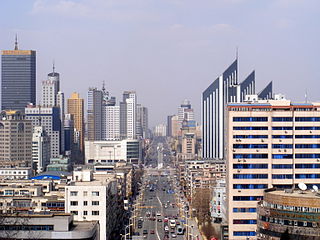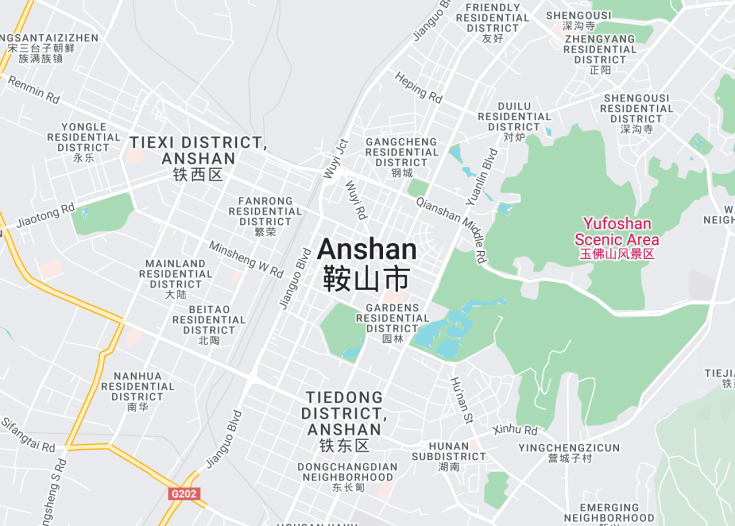Anshan, located in the Liaoning Province of China, is a city rich with historical significance and diverse natural landscapes. Known as the “Steel Capital of China,” it has been pivotal in the country’s industrial development. Visitors can explore its large steel complexes and delve into its deep-rooted culture at the Anshan Jade Buddha, the largest jade Buddha statue in the world. Qing Dynasty remnants offer a rare glimpse into China’s imperial past. Additionally, its lush parks and hot springs provide a refreshing retreat from the urban bustle.
For a unique experience in Anshan, visit during the late spring or early autumn when the weather is most favorable for exploring the city’s rich heritage and beautiful natural scenery.
Consider booking a tour of the Anshan Iron and Steel Complex to gain an insightful understanding of the city’s industrial history and significant role in China’s development.
Top things to do & see in Anshan
Select the following sights and activities to discover best tickets and tours available in Anshan.
Anshan: The Steel Heart of Northeast China
| Country | China |
| Time in Anshan | GMT+8 |
| Language spoken | Mandarin Chinese |
| Population | 3,584,000 (Statistics Bureau, 2021) |
| Currency | Renminbi (¥, CNY) |
| Airports |
|
Located in Liaoning Province, China, Anshan is a key city in the Northeast area renowned for its heavy industries, particularly iron and steel production. The city’s history stretches back over 3,000 years, making it one of the historical centers of ancient Chinese civilization. Modern Anshan, however, has developed around its abundant natural resources, chiefly iron ore, which has shaped its economy and physical landscape since the early 20th century.
Anshan’s prominence emerged with the establishment of its iron and steel company, Ansteel, which became one of the largest of its kind in China. Economic reforms in the late 20th century saw Anshan reinvigorating its industrial base, leading to expansive urban development. Today, apart from its steel industry, Anshan has diversified into sectors such as high-tech industries, software, and agricultural products processing.
Despite its industrial backbone, Anshan is also known for its natural beauty and cultural heritage. It is home to the Qianshan National Park, often referred to as the “Northeast Pearl,” boasting a unique blend of natural scenery and religious sites. The city also celebrates many traditional Chinese festivals, which are vibrant and attract tourists interested in experiencing local culture and traditions.
The development of tourism has led to improved entertainment and leisure facilities. From hot springs to lush green parks and a range of museums, including the Anshan Jade Buddha, the city offers a peaceful retreat alongside its bustling urban environment. Educational institutions in Anshan also attract students and researchers from across the country, contributing to its cultural diversity and vibrant intellectual life.
Moreover, Anshan’s strategic location as a transportation hub in Northeast China facilitates easy access to major cities such as Shenyang and Dalian, enhancing its position in regional logistics and trade.
Where is Anshan?
Located in Northeast China, Anshan is nestled in the central part of Liaoning Province, part of the ancient Chinese civilization cradle.
Distances:
| Route | Distance by car | Time by car |
|---|---|---|
| Anshan to Shenyang | 54 miles (88 km) | 1 hr 15 min |
| Anshan to Dalian | 193 miles (311 km) | 3 hrs 45 min |
What is Anshan famous for?
Anshan is chiefly renowned for its iron and steel industry, being a pivotal city in China’s heavy industry sector. It also boasts the Qianshan National Park, a beautiful blend of spiritual sites and natural beauty.
History
Prehistoric Times to Han Dynasty (Before 206 BC)
The area of Anshan has been inhabited since prehistoric times. The discovery of jade artifacts and the remnants of ancient villages suggest it was a significant location for early humans in Liaoning province. During the Zhou Dynasty (1046-256 BC), Anshan was known as a place rich in iron, helping the region to become an early center of iron smelting in China.
Three Kingdoms to Yuan Dynasty (220 – 1368 AD)
During the Three Kingdoms period, Anshan frequently changed hands between warring factions. Its strategic importance was primarily due to its resources and geographical location. By the time of the Tang and Song dynasties, Anshan was developing into a more substantial urban area, benefitting from advances in iron smelting techniques and trade with other regions.
Ming Dynasty to Republic of China (1368 – 1949)
In the Ming Dynasty, Anshan was fortified with walls, and the community inside thrived on its ironworks. The Qing Dynasty saw further development, but it was during the Japanese occupation from 1931 to 1945 that Anshan truly transformed. The Japanese built a major steelworks factory, which turned Anshan into one of the most important industrial centers for Japan’s war effort. After World War II and the establishment of the People’s Republic of China, Anshan continued to expand its steel industry.
Modern Era (1949 – Present)
Post-1949, Anshan has become one of China’s main centers for steel production. The establishment of the Anshan Iron and Steel Group Corporation has been integral to the city’s economic development. Over recent years, Anshan has focused not only on heavy industry but also on diversifying its economy, embracing technology, tourism, and the service sectors, reflecting the dynamic transformation from an industrial city to a multifaceted urban area.
Visit Anshan
What to see and do in Anshan, China
Visitors to Anshan can explore a wide variety of attractions. The city is renowned for its historical sites like the Anshan Jade Buddha, which is the largest jade Buddha statue in the world. Those interested in industrial tourism can visit the Anshan Iron and Steel Factory to witness the might of China’s steel industry first-hand.
- Explore the Qianshan National Park for its scenic beauty and spiritual significance. It hosts several Buddhist and Taoist temples.
- Visit the 219 Park, a local favorite, which offers a peaceful retreat with its beautiful lakes and green spaces.
- Explore the Anshan Museum to learn about the city’s iron and steel production history and its role in modern China.
Festivals and Events
Anshan’s cultural calendar is highlighted by several events reflecting its rich heritage. The Anshan International Steel & Iron Festival, celebrated annually in September, showcases the city’s industrial strength with exhibitions, trade fairs, and cultural performances. Furthermore, the Lunar New Year and Mid-Autumn Festival are lively times to experience traditional Chinese festivities in Anshan.
Best time to visit Anshan
To experience Anshan comfortably with more favorable weather, the optimal times to visit are during spring (April to June) and autumn (September to October). These seasons offer mild temperatures and less rainfall, making it ideal for exploring the city’s outdoors activities and cultural sites.
Is Anshan worth visiting?
Anshan offers a distinctive blend of industrial heritage, cultural depth, and natural beauty, making it worth a visit for those intrigued by China’s historical evolution and its modern-day capabilities.
While the city primarily appeals to those fascinated by industrial tourism, the scenic landscapes of Qianshan National Park and rich cultural experiences during major festivals provide a compelling reason for broader interest. Potential visitors should consider the city’s heavy industrial base, which might not appeal to everyone, and plan their trip during the cooler months for the best experience.









